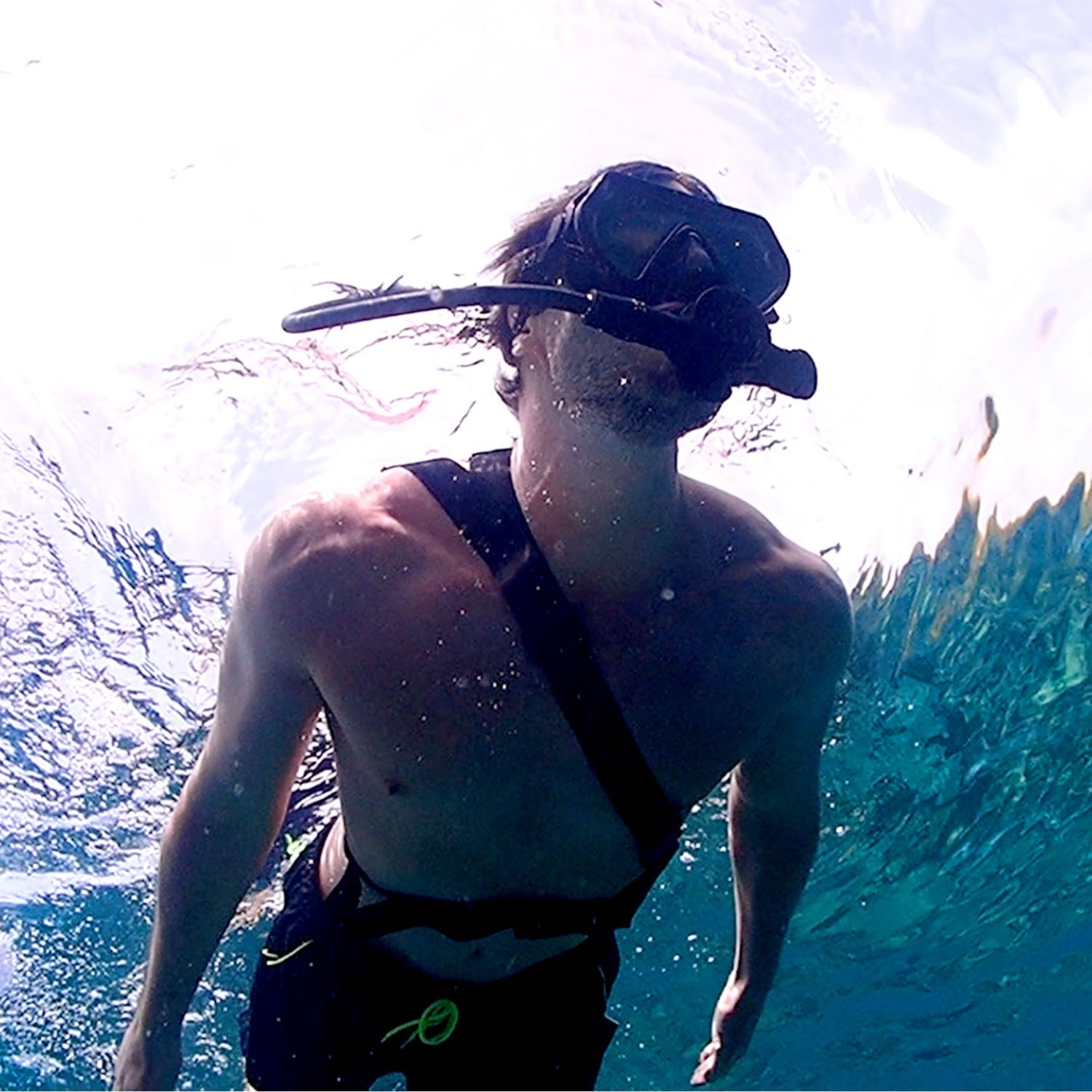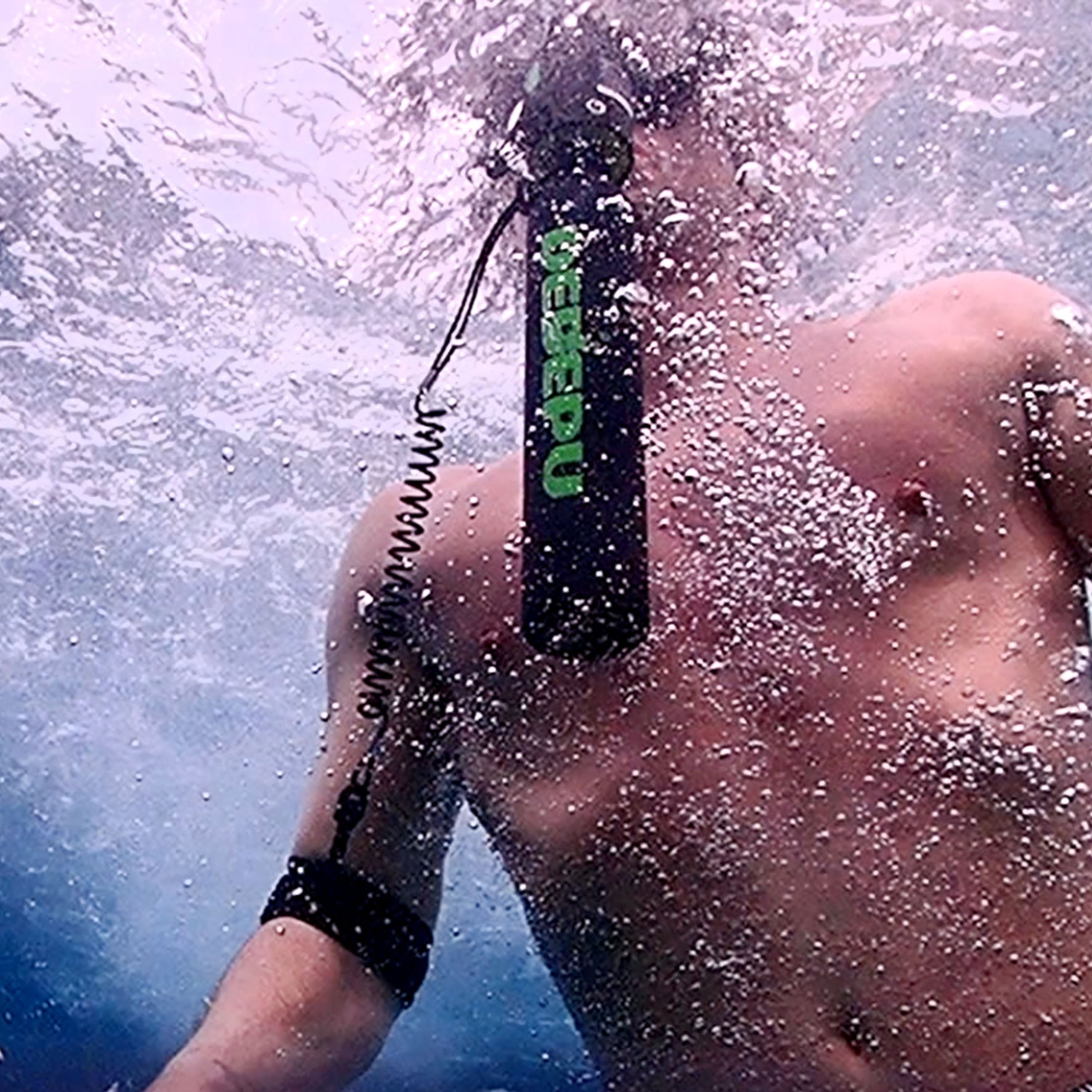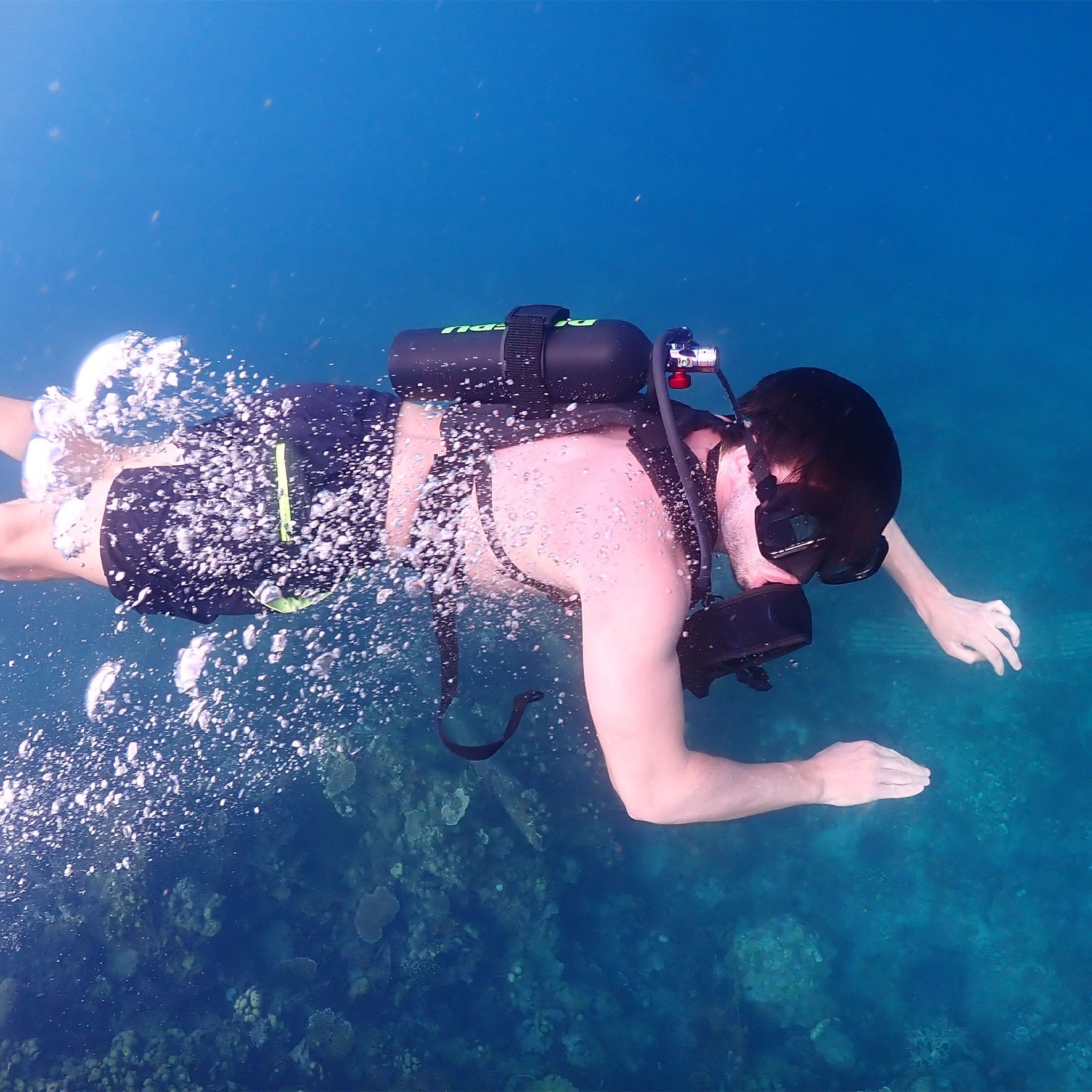Wondering how long a 1L scuba tank lasts? The answer depends on depth, breathing rate, and tank pressure. For example, at 10 meters (33 feet), an average diver breathing 15-20 liters per minute might get only 2-3 minutes of air from a 1L tank at 200 bar. In shallow water (3-5 meters), it could stretch to 5-8 minutes.
What Affects a 1L Tank’s Air Time?
A 1L scuba tank is tiny compared to standard 12L tanks, but it’s useful for short dives or emergency backup. Its air supply depends on three main things: depth, breathing rate, and tank pressure.
Depth: At 10 meters (33 feet), pressure doubles, so you consume air twice as fast as at the surface. A 1L tank at 200 bar holds 200L of air—but at 10m, that’s effectively just 100L of usable air.
Breathing Rate: Most divers use 15-25L per minute at rest. If you breathe 20L/min, a 200L tank lasts 10 minutes at the surface—but only 5 minutes at 10m.
Tank Pressure: A full 1L tank at 200 bar has 200L of air. If it’s only filled to 100 bar, you get half the air (100L), cutting dive time significantly.
1. Depth: The Biggest Air Killer
Deeper = faster air consumption. Here’s why:
Surface (0m): 1L of tank air = 1L of breathable air.
10m (33ft): Pressure is 2x, so 1L of tank air = 0.5L of breathable air.
20m (66ft): Pressure is 3x, so 1L of tank air = 0.33L of breathable air.
Example:
A 200L tank lasts:
20 minutes at the surface (breathing 10L/min).
10 minutes at 10m (same breathing rate).
6-7 minutes at 20m.
Key Takeaway: If you need longer air time, stay shallow.
2. Breathing Rate: Control It to Save Air
Your air use varies wildly based on activity:
Resting (calm diver): 10-15L/min
Moderate swimming: 20-25L/min
Stressed or working hard: 30-40L/min
Example:
A 200L tank with 20L/min breathing:
10 minutes at the surface.
5 minutes at 10m.
If you slow breathing to 12L/min:
16 minutes at the surface.
8 minutes at 10m.
Key Takeaway: Relax, move slowly, and breathe deeply to extend dive time.
3. Tank Pressure: The Starting Point Matters
A 1L tank at 200 bar = 200L of air. But if underfilled, dive time drops fast.
Full tank (200 bar): 200L → 10 min at surface (20L/min).
Half-full (100 bar): 100L → 5 min at surface.
Low (50 bar): 50L → 2.5 min at surface.
Key Takeaway: Always check your tank’s pressure before diving. A 1L tank is only practical for very short dives unless you’re extremely efficient.
Thought
A 1L tank is not for long dives—it’s best for:
Emergency backup (pony bottle).
Surface-supplied snorkeling.
Very short shallow dives (1-3 min).
If you need more air, go for a 5L+ tank. But if you’re stuck with 1L, stay shallow, breathe slow, and monitor pressure closely.

Calculating Air Use
A 1L tank at 200 bar holds 200L of compressed air.
At the surface (0m), you breathe air at 1:1 pressure—so 200L = 200L of usable air.
At 10m (33ft), pressure doubles, so 200L in the tank = 100L of actual breathable air.
If you breathe 20L per minute, a full tank gives you:
10 minutes at the surface (200L ÷ 20L/min).
5 minutes at 10m (100L ÷ 20L/min).
1. The Basic Formula: Tank Capacity ÷ (Breathing Rate × Pressure Factor)
To estimate air time, use this simple equation:
Dive Time (min) = (Tank Volume × Pressure) ÷ (Breathing Rate × Absolute Pressure)
Tank Volume: 1L (or 1000mL).
Pressure: 200 bar (full tank) → 200L total air.
Breathing Rate: 15-25L/min (average diver).
Absolute Pressure: 1.0 at surface, 2.0 at 10m, 3.0 at 20m.
Example Calculation (Surface Dive):
Tank: 1L × 200 bar = 200L.
Breathing: 20L/min.
Pressure factor: 1.0 (surface).
Dive Time = 200L ÷ (20L/min × 1.0) = 10 minutes.
At 10m Depth:
Same tank (200L), but pressure factor = 2.0.
Usable air = 200L ÷ 2 = 100L.
Dive Time = 100L ÷ 20L/min = 5 minutes.
2. Real-World Adjustments: What Changes the Numbers?
Theoretical calculations don’t always match reality. Here’s what affects real dive time:
Breathing Efficiency:
Calm diver: 12-15L/min → Longer air supply.
Stressed diver: 30L/min+ → Cuts dive time in half.
Tank Fill Accuracy:
A "200 bar" fill might actually be 190-210 bar (±5%).
A 10% underfill means 180L instead of 200L—losing 1-2 minutes.
Air Reserve Rule:
Never plan to use 100% of tank air.
Always surface with at least 50 bar (25% reserve).
So 200L becomes 150L usable at surface (7.5 min instead of 10).
3. Quick Reference: Estimated Dive Times for 1L Tank
| Depth | Breathing Rate (L/min) | Usable Air (L) | Estimated Time |
|---|---|---|---|
| 0m | 15 | 200 | 13.3 min |
| 0m | 20 | 200 | 10 min |
| 10m | 20 | 100 | 5 min |
| 20m | 25 | ~67 | 2.7 min |
Key Takeaways:
Shallow dives (<5m) give 5-10+ minutes with a 1L tank.
Beyond 10m, air runs out very fast—often <5 minutes.
Breathing control is the easiest way to extend dive time.
Thought
A 1L tank is only practical for:
Very short dives (under 5 minutes).
Emergency backup (if you stay shallow).
Testing gear in a pool.
If you need more air, use a bigger tank (5L+) or stay above 5m depth. But if you’re stuck with 1L, do the math beforehand so you don’t run out unexpectedly.
How Depth Changes Air Consumption
At 5m (16ft), a 1L tank at 200 bar gives ~7 minutes of air (breathing 20L/min).
At 20m (66ft), the same tank lasts under 3 minutes—less than half the time.
For every 10m (33ft) deeper, you lose ~50% of your usable air due to pressure.
1. Shallow Dives (0-5m / 0-16ft): Maximizing Air Efficiency
Best for extending dive time with a small tank.
Pressure factor: 1.0-1.5x (minimal air loss).
Air consumption: Near-surface rates.
Example (1L tank, 200 bar, 20L/min breathing):
0m: 200L ÷ 20L/min = 10 minutes.
5m: 200L ÷ (20L/min × 1.5) = ~6.7 minutes.
Real-world adjustment:
Calm divers (12-15L/min) get 10-13 minutes at 5m.
Stressed divers (30L/min) drop to ~4.5 minutes.
Best uses for 1L tanks:
Snorkeling with short dives (2-3m depth).
Pool training (constant 1-2m depth).
Emergency surface swimming (minimal depth).
2. Mid-Depth Dives (10-15m / 33-49ft): The Turning Point
Where air starts disappearing fast.
Pressure factor: 2.0-2.5x.
Air consumption: Double the surface rate.
Example (same tank/breathing rate):
10m: 200L ÷ (20L/min × 2.0) = 5 minutes.
15m: 200L ÷ (20L/min × 2.5) = 4 minutes.
Critical factor:
A 5m change (10m → 15m) cuts air time by 20%.
Ascending to 5m from 15m triples remaining air time.
When 1L tanks fail here:
Dives >5 minutes require strict depth control.
Any task loading (e.g., photography) spikes air use to 25-30L/min → ~3 minutes total.
3. Deep Dives (20m+ / 66ft+): Why 1L Tanks Aren’t Practical
At this point, air lasts shorter than most safety stops.
Pressure factor: 3.0x at 20m, 4.0x at 30m.
Example:
20m: 200L ÷ (20L/min × 3.0) = ~3.3 minutes.
30m: 200L ÷ (20L/min × 4.0) = 2.5 minutes.
Reality check:
Descent/ascent takes ~1-2 minutes → Only ~1 minute of bottom time at 30m.
Safety stop (5m for 3 minutes): Impossible without reserve air.
Why divers avoid 1L tanks deep:
No margin for error (equipment issues, currents).
Violates standard safety protocols (reserve air rules).
4. Key Takeaways: Depth vs. Air Time
| Depth | Pressure Factor | 1L Tank Duration (20L/min) | Safe Practical Use? |
|---|---|---|---|
| 0-5m | 1.0-1.5x | 6-10 minutes | ✅ Yes (best case) |
| 10m | 2.0x | 5 minutes | ⚠️ Risky (short dives only) |
| 20m | 3.0x | ~3 minutes | ❌ No (unsafe) |
Actionable tips:
For 1L tanks, stay <10m—ideally <5m for meaningful dive time.
Monitor depth closely: A 2-3m change can add/subtract 1-2 minutes.
Always surface with reserve (at least 50 bar in the tank).
Tips to Make Your 1L Tank Last Longer
A 1L scuba tank doesn’t give you much air—200L max at 200 bar. At 10m depth, that’s just 100L usable, lasting ~5 minutes for an average diver.
Slow your breathing rate from 20L/min to 12L/min → +40% more dive time (7 min instead of 5 min at 10m).
Reduce movement → Cuts air use by 15-25%.
Stay shallow → Every 2m (6.5ft) deeper costs ~1 extra minute of air.
1. Optimize Your Breathing (The Biggest Saver)
Breathing control = 30-50% longer dives.
Normal rate: 20L/min → 5 min at 10m.
Trained slow rate: 12L/min → 8.3 min at 10m (+66% time).
How to improve:
Breathe deeply & slowly (aim for 6-8 breaths per minute vs. typical 10-12).
Exhale fully—incomplete exhalation wastes 10-15% of each breath.
Avoid breath-holding—it increases CO₂, making you breathe faster later.
Pro tip: Practice dry breathing drills (e.g., 4-sec inhale, 6-sec exhale) to build efficiency.
2. Minimize Movement (Drag Kills Air Fast)
Swimming effort directly impacts air use:
Gentle finning: 15L/min consumption.
Moderate swimming: 20-25L/min.
Hard kicking/currents: 30L/min+ → Cuts dive time in half.
Ways to reduce effort:
Streamline gear—remove dangling accessories adding drag.
Use slow, wide fin strokes (better propulsion per kick).
Drift when possible—let currents carry you instead of fighting them.
Data point: A 10% reduction in speed can save 20% air due to lower drag.
3. Stay Shallow (Depth = Exponential Air Loss)
Every meter deeper = less time:
| Depth | Pressure Factor | 1L Tank Time (20L/min) |
|---|---|---|
| 3m | 1.3x | 7.7 min |
| 5m | 1.5x | 6.7 min |
| 10m | 2.0x | 5 min |
Tactics:
Plan dives at 3-5m instead of 10m → +2-3 minutes of air.
Avoid descending unless necessary—hover slightly above your target.
Ascend early for safety stops—saves air vs. rushing later.
4. Gear Tweaks (Small Changes = Big Savings)
Equipment choices affect efficiency:
Regulator performance: A high-efficiency reg saves 5-10% air vs. an older model.
Tank material: Lightweight aluminum reduces buoyancy shifts → Less effort adjusting.
Exposure suit: Thicker wetsuits increase drag → +10-15% air use in cold water.
Pro move: Test gear in a pool first to spot air-wasting issues.
5. Mindset Matters (Stress = Air Killer)
Panic or task-loading spikes consumption:
Calm diver: 12-15L/min.
Stressed diver: 25-40L/min → 2-3x faster air drain.
How to stay relaxed:
Plan simple dives—no complex navigation with a 1L tank.
Check pressure gauge often—every 30 seconds to avoid surprises.
Abort early if something feels off—better to surface with air left.
Quick Reference: Air-Saving Hacks
| Technique | Air Savings | Effect on 10m Dive (20L/min → ?) |
|---|---|---|
| Slow breathing (20→12L/min) | 40% | 5 min → 8.3 min |
| Reduce movement (20→15L/min) | 25% | 5 min → 6.7 min |
| Stay at 5m vs. 10m | 25% | 5 min → 6.7 min |
| Streamline gear | 10-15% | 5 min → 5.5 min |
Thought
A 1L tank is limited, but smart habits can give you 30-70% more time. Prioritize:
Breathe slower (biggest gain).
Move less (easy wins).
Stay shallow (depth is costly).
For dives >5 minutes, upgrade to a 5L+ tank. But if you’re stuck with 1L, every saved liter counts.

Comparing 1L to Larger Tanks
A 1L scuba tank holds 200L of air at 200 bar, giving just 5-10 minutes at shallow depths—barely enough for a quick dip. Compare that to:
5L tank (1000L): 25-50 min at 5m
12L tank (2400L): 60-120 min at 5m
That’s why 95% of recreational divers use 10-12L tanks. But 1L tanks aren’t useless—they excel in specific niche cases. Here’s the full breakdown.
1. Air Capacity: Why Size Matters
A 1L tank is like a motorcycle gas tank—lightweight but impractical for long trips. Here’s how it stacks up against standard tanks:
At the surface (0m):
1L tank: ~10 minutes (breathing 20L/min)
5L tank: ~50 minutes
12L tank: ~120 minutes
At 10m depth:
1L tank: ~5 minutes (pressure halves usable air)
5L tank: ~25 minutes
12L tank: ~60 minutes
Key Takeaway: A 5L tank gives 5x more dive time than 1L, while a 12L tank lasts 12x longer. Unless you’re doing ultra-shallow dives, bigger tanks are the only practical choice.
2. Why Divers Rarely Use 1L Tanks
Five Dealbreakers
Time Crunch
At 15m, a 1L tank lasts under 4 minutes—barely enough to descend, look around, and ascend. Most dives need 20+ minutes to be worthwhile.
No Safety Margin
Divers are trained to surface with 50 bar reserve. For a 1L tank, that means ending the dive at 150L usable air—just 3-4 minutes at depth.
Depth Penalty
Below 10m, air vanishes twice as fast. A 1L tank at 20m gives ~3 minutes—too risky for recreational diving.
Task Loading Problems
Any extra effort (fighting currents, photography) spikes air use to 30L/min+, draining a 1L tank in 2-3 minutes.
Emergency Uselessness
If your buddy runs out of air, a 1L tank can’t help much—it might buy 30 seconds of shared breathing at depth.
3. When a 1L Tank Actually Makes Sense
Four Niche Uses
Snorkeling Support
For short underwater passes (1-2m depth), a 1L tank adds 5-8 minutes of air without heavy gear.
Pony Bottles (Emergency Backup)
As a bailout tank, a 1L (filled to 300 bar) provides ~3 minutes at 20m—enough for a controlled ascent.
Pool Training
Ideal for mask clearing or regulator recovery drills where air needs are minimal.
Technical Diving
Some cave divers use 1L tanks for shallow decompression stops (5-6m), where gas needs are tiny.
4. Cost and Practical Considerations
Breaking Down the Tradeoffs
Price: A new 1L tank costs 80-120, while a 12L tank runs 200-400. But the 12L gives 12x more air per dollar.
Weight: A 1L tank weighs 1.2kg (2.6lbs) empty, vs. 15kg (33lbs) for 12L—but most divers accept the tradeoff for longer dives.
Air Fills: Filling a 1L tank costs 2-5, but you’ll need 12 fills to match one 12L tank fill (5-10).
Reality Check: Dive shops rarely rent 1L tanks because they’re impractical for most divers. If you’re serious about diving, a 5L or larger tank is the smarter investment.
5. Advice: Who Should Use a 1L Tank?
✅ Good for:
Surface snorkeling boosts
Ultra-lightweight backup air
Pool training drills
❌ Bad for:
Recreational diving
Dives below 10m
Any dive longer than 5 minutes
Pro Tip: If you want compact gear but more air, a 3L or 5L tank is the smallest realistic option for actual diving.
Bottom Line
1L tanks are specialty tools, not primary gear. They work for:
Emergency reserves
Very shallow, brief dives
Controlled training environments
For real diving, 5L+ tanks are the minimum. Choose based on your depth and time needs—not just size.




Laisser un commentaire
Tous les commentaires sont modérés avant d'être publiés.
Ce site est protégé par hCaptcha, et la Politique de confidentialité et les Conditions de service de hCaptcha s’appliquent.